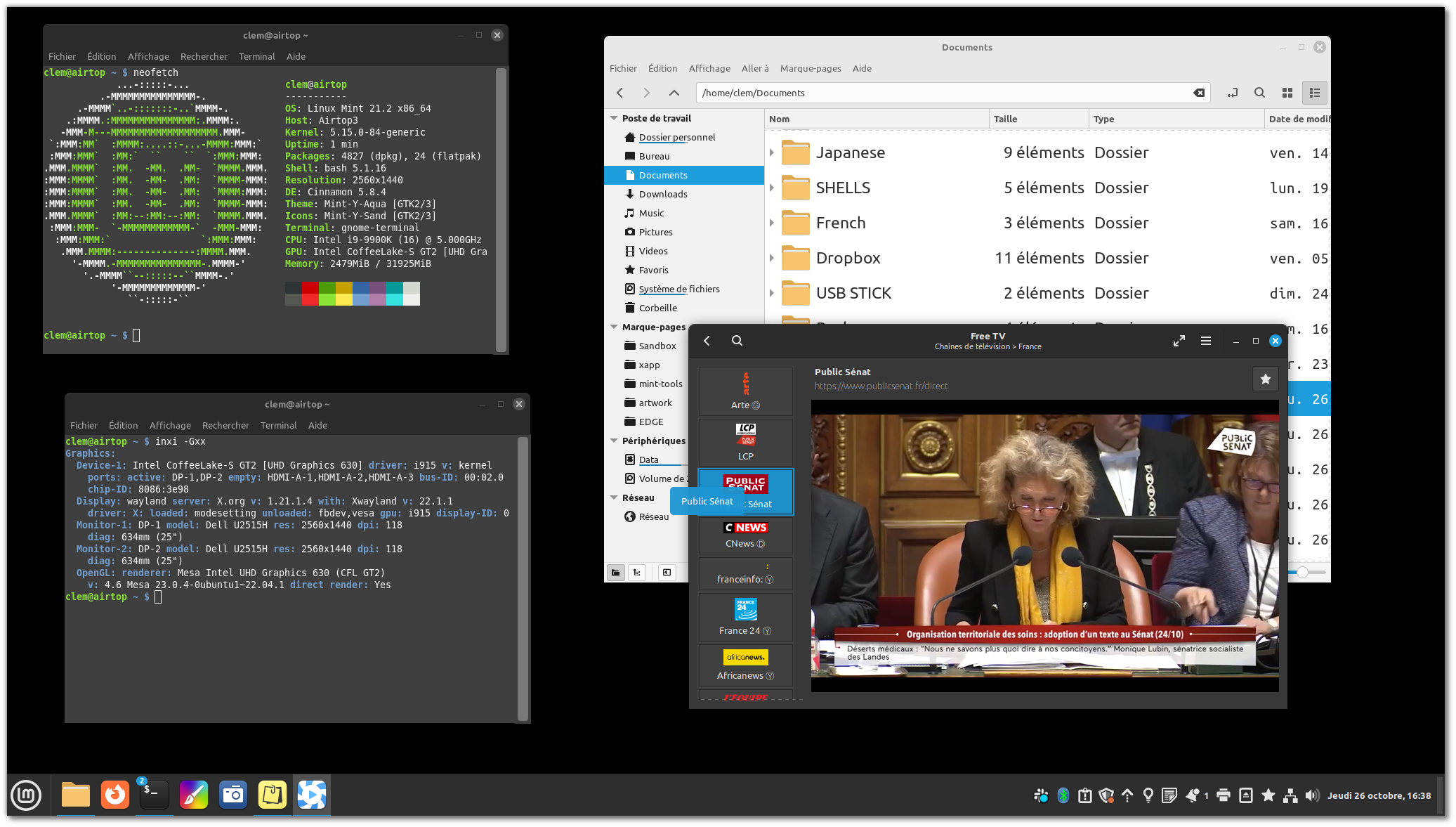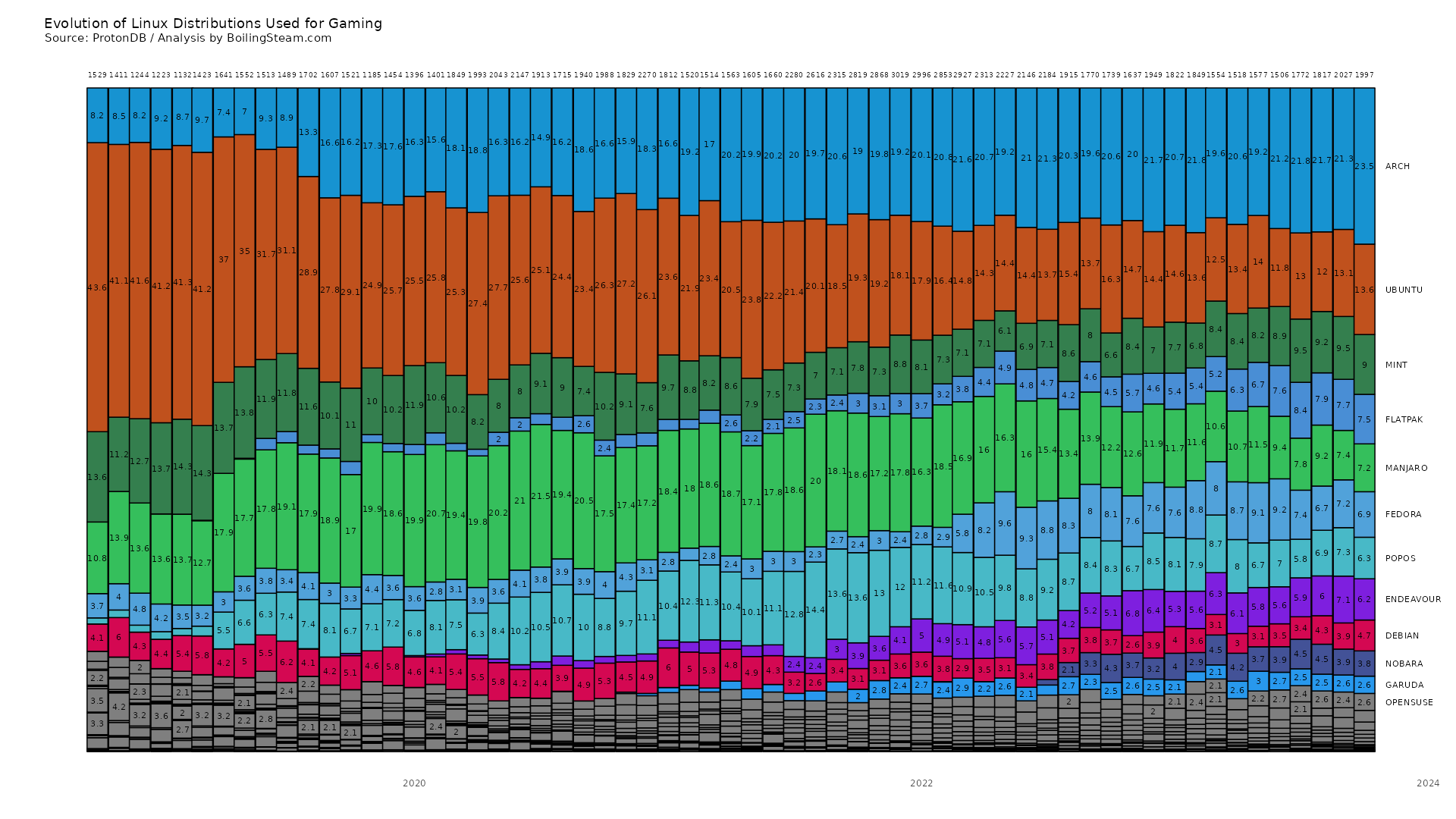Goodbye Manjaro! Update on the Evolution of Distros Used for Gaming - Nov 2023
It’s been about six months we had an update on the distros used for gaming on Linux, and it’s time for a refresh. As a reminder, we use ProtonDB for this analysis. The way it works is that we extract configuration data from every report, and turn it into unique identifiers which tentatively correspond to a single user at least on a given month. We then look at what distros are used by each unique user on a monthly basis, and we end up with the below graph. As you can expect, there are variations from month to month, but the trends are fairly clear once you extend your horizon to 3 to 6 months. I highly recommend that you click on the picture to see more details, as it’s likely going to be hard to read otherwise:
We typically get a lot of questions about Flatpak, such as “Why is Flatpak there? It’s not a distro!”. This is true, but it’s a lot more nuanced than that. When you run Steam through Flatpak, you almost use nothing from your host distro in the first place (apart from the kernel and a few libs). The base OS environment, the graphics drivers are also encapsulated in isolated environments that end up running Steam, so in effect you are using something that is not related to your host distro. So, while strictly speaking not being a distro, it’s certainly an environment that is different from whatever distro you are running, and worth tracking as such.
Back to the chart, we have also prepared an animated view of the very same data, in case you prefer something that moves with a bit of music:
So, what are the key observations we can make?
Manjaro is on the way out?
We had already observed previously that Manjaro was losing steam, but the trend is now accelerating. It used to be in a second spot after Arch, and has now fallen very far behind, with just 7% share (it used to have 20% in late 2021!). There seems to be nothing to save it from falling behind even further. I hardly go a few days without seeing negative comments about Manjaro and people exhorting Linux users to move to something else and certainly not start with that one anymore.

I would not be surprised if we see it going the way of Antergos (that disappeared after having some initial success as an easy way to install Arch).
Arch Still the King
Despite all the movements that we see below, there’s one constant in this graph: the stability of Arch Linux as one of the key distro choices. It’s been at a steady 20%+ share for years now, and it’s still gaining a few percents here and there over time. Note that this graph is not related to the Steam Deck at all. The ProtonDB data that we use concerns Desktop use (there are very few reports with SteamOS Holo) as the Steam Deck reports are tracked in a separate way in ProtonDB. Still, the fact that Valve chose Arch Linux as a base for the Steam Deck may have given further exposure to the distro, so we can’t completely discount some kind of halo effect.
Ubuntu Still Hanging on
There’s hardly a sign of recovery for Ubuntu, but it’s not falling further either, hovering at about 10~15% of usage of a monthly basis. With Manjaro mostly gone from the picture, it looks like Ubuntu is going to stay in this position for a while now as there’s no other contender in the same range. Note that we typically see a spike of Ubuntu usage every time a new version is released (such as 23.10 Mantic recently) so the slight increase in the share we can observe in the october data may be linked to that.
Pop!_OS vs Mint
They are both Ubuntu derivatives and both are well known for offerining a much more polished experience vs the base Ubuntu install, with additional tools to make your life easier, and a bunch of bugs ironed out. In a surprising turn of events, Pop!_OS used to a clear lead over Mint up until a few months back, but it now looks like Mint is clearly ahead. I call it surprising, because Mint is mostly a quiet distro: it does not make much headlines and is hardly the subject of passionate discussions. Pop!_OS has been in the news several times since they are also working on their own custome DE called Cosmic. In any case, in my experience they are both good choices if you want to stay in the Ubuntu realm - both offer solid experiences over a generic Ubuntu install. By the way, Mint is working to transition Cinnamon (its official DE) to Wayland at some point, but it’s not ready for prime time yet. Here’s a screenshot they shared about their experimental build using Wayland:

The Fedora and Nobara Gang
After some sudden spike of popularity in the middle of 2022, the excitement around Fedora has slowed down a little. It’s mostly stable at around 7% of share. Nobara was one of the fastest growing distros as well (based on Fedora), but it has also slowed down and seems to have found its space right now at about 4% share. I wonder if its slight decline or lack of growth is linked in any way with the bad press that has been surfacing about Red Hat and related CentOS news in 2023.
What’s Next?
There are rumors circulating that Valve is going to release SteamOS later this year (really?) - I am not sure how much credence we should give to such rumors, but if they do, we might start seeing SteamOS back in such charts in the near future, since it would be a very good candidate for a distro actually made for Gaming. SteamOS would offer advantages such as Gamescope being baked in, and potentially HDR supported first before anywhere else (at least on some of the supported hardware). There’s still a big question mark if we would see proper Nvidia support in a SteamOS build. But AMD GPUs users may consider it as a viable alternative.
In any case, we will be back in a few months from now with the latest trends if we see any hint of a change.

